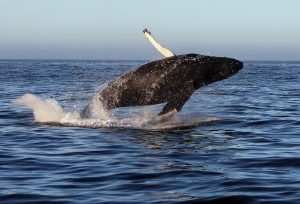
Monterey Bay National Marine Sanctuary is referred to some as the “Serengeti of the Sea” due to the large number of marine mammals living in or swimming through sanctuary waters. This summer, undergraduate intern Katie Rice from UC Berkeley tackled a tall task in determining the number of species occurring in the sanctuary.
Katie, with guidance from local scientists, developed a process that could be used to determine the number of species found in any sanctuary. Part of this involved using existing online databases, published records, expert opinion, and local observations. For some groups (or Phyla), such as the Mollusca, this is a daunting task since at least 85,000 species are currently recognized globally, and there are likely well over 1,000 molluscs in the sanctuary.
For other groups, like marine mammals (subset of Class Mammalia, in Phylum Chordata), the task is much more manageable due to low numbers of species that live in or transit through the sanctuary, as well as the large size of these animals and their beloved status by the public. Sightings data are much more common, and there are extensive programs that monitor the health of marine mammal populations. Several marine mammal species are either threatened or endangered, and there are ongoing efforts to restore these populations.
In spite of the relatively manageable number of marine mammals, there remain questions about whether to count a species that resides in the sanctuary or simply is passing through. For the purposes of this updated list of marine mammals in Monterey Bay NMS, we decided to rely on species sightings as the minimum criterion. Below is a list of 36 marine mammals observed in Monterey Bay NMS:
| Common name | Genus | species | Comment |
| Baird’s beaked whale | Berardius | bairdii | |
| Blainville’s beaked whale | Mesoplodon | densirostris | Rare |
| Blue whale | Balaenoptera | musculus | Uncommon |
| Bottlenose dolphin | Tursiops | truncatus | |
| Bryde’s whale | Balaenoptera | edeni | Rare |
| California gray whale | Eschrichtius | robustus | |
| California Sea Lion | Zalophus | californianus | |
| Cuvier’s beaked whale | Ziphius | cavirostris | Uncommon |
| Dall’s porpoise | Phocoenoides | dalli | |
| Dwarf sperm whale | Kogia | sima | Uncommon |
| False killer whale | Pseudorca | crassidens | Rare visitors during warm water events in Monterey Bay |
| Fin whale | Balaenoptera | physalus | |
| Guadalupe Fur Seal | Arctocephalus | townsendi | Uncommon |
| Harbor porpoise | Phocoena | phocoena | |
| Harbor Seal | Phoca | vitulina | |
| Hubbs’ beaked whale | Mesoplodon | carlhubbsi | Uncommon |
| Humpback whale | Megaptera | novaeangliae | |
| Killer whale | Orcinus | orca | |
| Lesser beaked whale | Mesoplodon | peruvianus | Rare; stranding in Monterey Bay |
| Long-beaked common dolphin | Delphinus | delphis bairdii | This species was recently returned to subspecies status, pending further review. It is now considered Delphinus delphus bairdii. |
| Minke whale | Balaenoptera | acutorostrata | |
| Northern Elephant Seal | Mirounga | angustirostris | |
| Northern Fur Seal | Callorhinus | ursinus | |
| Northern right whale dolphin | Lissodelphis | borealis | |
| North Pacific right whale | Eubalaena | japonica | |
| Pacific white-sided dolphin | Lagenorhynchus | obliquidens | |
| Pygmy sperm whale | Kogia | breviceps | Uncommon |
| Risso’s dolphin | Grampus | griseus | |
| Sei whale | Balaenoptera | borealis | Uncommon |
| Short-beaked common dolphin | Delphinus | delphis delphis | |
| Short-finned pilot whale | Globicephala | macrorhynchus | Uncommon |
| Southern sea otter | Enhydra | lutris nereis | |
| Sperm whale | Physeter | macrocephalus | Uncommon |
| Stejneger’s beaked whale | Mesoplodon | stejnegeri | Rare |
| Steller Sea Lion | Eumetopias | jubatus | Uncommon |
| Striped dolphin | Stenella | coeruleoalba | Found very far off shore |
This list was reviewed by Dr. Karin Forney, a NOAA scientist who has, since 1987, conducted research on the abundance, distribution, ecology, and status of over 25 species of cetaceans (whales, dolphins and porpoises) in the eastern and central North Pacific Ocean, with emphasis on small cetaceans. The list was also reviewed by Dr. Jim Harvey, Professor of Vertebrate Ecology and current Director of Moss Landing Marine Laboratories. Since the mid-1970s Dr. Harvey has studied the ecology, morphology, and behavior of marine mammals, birds, and turtles; used VHF/satellite-telemetry; investigated marine mammal/fisheries interactions; developed vertebrate sampling techniques and experimental design; tracked population and trophic dynamics; and conducted marine mammal stranding studies.
How many will you see during a whale watching cruise? Over the course of a year, 20 species sighted is typical, but on any individual cruise it could be much less, depending on the time of year, ocean conditions, and where the vessel is located.